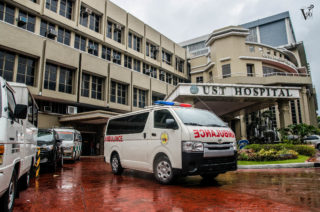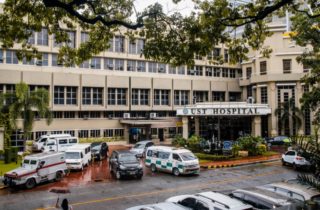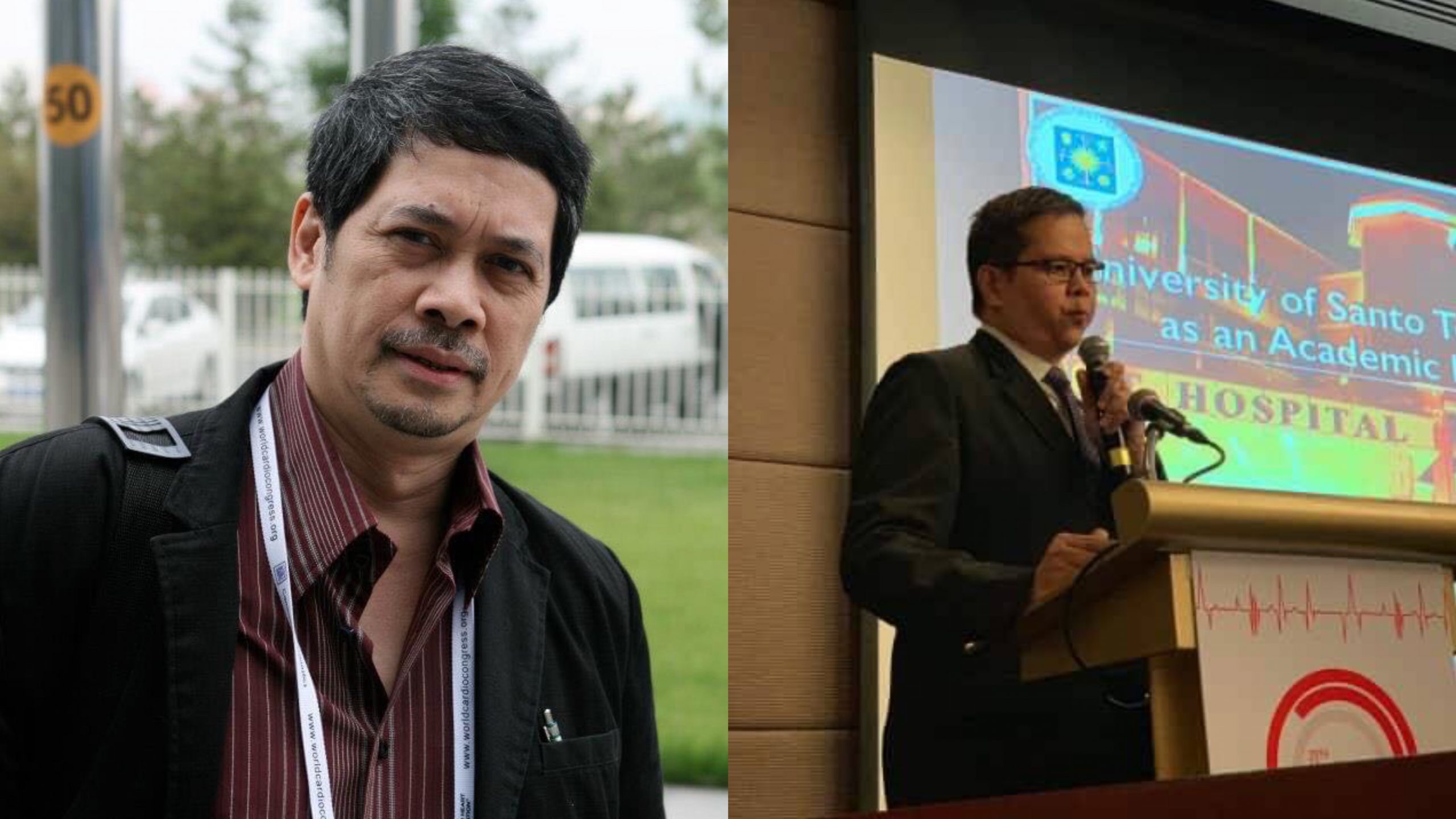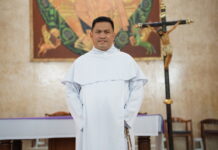The Covid-19 response has been likened to a war against an “invisible enemy” – a highly contagious and deadly disease. If doctors, nurses and other healthcare workers are the front liners, then hospital directors are the field generals, strategizing and managing resources to win the battle against the coronavirus.
Two Thomasians at the helm of major hospitals, Makati Medical Center and UST Hospital, are facing considerable odds amid depleted staff, a surge of patients, the shortage of personal protective equipment (PPE), and lack of space.
But Dr. Saturnino Javier (Medicine, 1984), medical director of Makati Medical Center and Dr. Marcellus Francis Ramirez (Medicine, 1996), the UST Hospital chief, are optimistic that they will pull through with the efforts of their medical and support staff and donations and expressions of support from the public.
Javier, a cardiologist who finished biochemistry in UST in 1980 while editor in chief of the Varsitarian, the University’s official student publication, was cheered by social media for his condemnation of Sen. Aquilino Pimentel III, who violated hospital protocol when he accompanied his pregnant wife for a scheduled delivery despite being a suspected Covid-19 case.
Senator Aquilino Martin Pimentel III breached MakatiMed hospital infection control protocols. pic.twitter.com/uPUVIF25Pb
— Makati Medical Center (@IamMakatiMed) March 25, 2020
Ramirez, also a cardiologist, meanwhile had to deal with some hostility in social media and rumblings within the UST Hospital workforce, but is buoyed by an outpouring of support in the form of food, PPEs, and even cards for patients, “from all walks of life.”
The Varsitarian reached out to Javier and Ramirez for their thoughts on the Covid-19 pandemic, and to ask how they are managing their respective teams and coping with the challenges of a global health emergency.
Here are their answers to our questions:
Varsitarian: How do you manage the hospital during the pandemic?
Dr. Saturnino Javier, medical director, Makati Medical Center: In general, we follow our own protocol so we try not to hold any face-to-face meetings. We hold teleconferencing using all available platforms, such as Viber or Zoom. We communicate with all the vital units from time to time regarding what protocols we need to implement. This started way back January 2020, overlapping with the Taal Volcano eruption. From that time, we implemented the protocol that we have for pandemic response. Many years ago, we had pandemic response protocols … [but] this is a different infection, it’s more infectious, highly contagious, so we even had to streamline and come up with stricter protocols to make sure that we are able to contain the spread of infection. In a general perspective, that was how we tried to respond to this corona outbreak. In terms of manpower, we make sure that we have the available frontliners from the medical, nursing and corporate standpoints.
Dr. Marcellus Francis Ramirez, medical director, UST Hospital: These are extraordinary and unprecedented times requiring extraordinary measures. In the first week alone, we encountered an avalanche of cases. The situation [became more] complicated, with a significant number of our healthcare staff exposed and mandated to be quarantined. At the same time, many hospital staff were not able to report for work when the enhanced community quarantine was ordered by the government. But the whole management team of the hospital was fully on-board during these times. Guideline-directed medical care was continued for the patients who were affected and who were admitted. Following protocol set by our Infection Prevention and Control Committee, patients were admitted in the designated isolation unit that was prepared as early as January.
V: Do you still go home? How far is your home? Do you have adequate transportation services to go to work and back home?
Javier: The ones who can go home, they go home. Anyway, they are not prevented from movement because they have hospital IDs. The others who cannot go home because they’re geographically too far away from the hospital, we have found some ways to provide accommodation. Some are from generous sponsors who provided some accommodations. The others, we have to source out. We have to rent some places for our hospital workers who cannot go home.
Ramirez: Fortunately, most of the management team reside in Quezon City and Makati and we have transportation to go to work. Most of us drive. One member however resides in Bulacan and was not able to report for a couple of days during the early part of the ECQ (enhanced community quarantine). For some of the hospital staff, transportation was a major problem and some could not report for work, especially those residing in Bulacan, Valenzuela and other areas. The hospital provided rooms to stay for the staff. The Dominican fathers also offered the Domus Mariae dormitory […], in which some staff stayed in.
V: How do you feel being one of the frontliners?
Javier: Of course [I] was scared at the start because going through what our colleagues in China, South Korea, Italy are going through, I was afraid not only for myself but for the entire healthcare community, which means the doctors, the nurses. However, the fear is tempered by faith, tempered by trust among the healthcare personnel that somehow we are empowered to do what we need to do by way of our previous experiences. We are empowered by the knowledge we have gathered from the other healthcare communities in Asia and in Europe, and then we are empowered by own faith in each other.
Ramirez: While it is easy to say that we are proud to be doing our duty and serve our patients in battling this pandemic, in reality, there is always a feeling of uncertainty and fear in each frontliner. Each minute, each second that one is in the emergency room or in the Covid unit attending to a patient, it is normal to be afraid that you might get the infection, that you might spread the infection to your family members and loved ones when you go home. But if we follow the proper protocol mandated by our Infection Prevention and Control Committee, and wear the proper protective equipment, and follow the necessary steps, then we need not be fearful. But we are definitely thankful for the outpouring of love and support by other people and organizations to the frontliners and to the institution.
V: What struggles does your hospital face amid the Covid-19 pandemic?
Javier: The struggles [of the hospital] are on the dwindling workforce, because some of them have to be quarantined when they have exposure to the [Covid-19] section, so frontliners from both ends, from the medical and nursing side. If we have doctors exposed to infections, we have to quarantine them, and that means a 14-day quarantine. It’s the same for nurses. Given the fact that you want to protect your “bench” of responders, we try to maximize our contingency teams by enforcing skeletal workforces. That means only those who need to be on duty are in the hospital. We try not to expose those who do not have to be in the hospital. We also mandated social distancing among healthcare personnel to prevent and contain the spread of infection.
Ramirez: As we enter our fifth week into this battle, we have come across a lot of realizations – that we can achieve so much with teamwork, cooperation, coordination, willpower and a lot of grit. Our first week was characterized by mayhem, with a lot of unexpected events, cases piling up in an unprecedented manner, coming from within the hospital and from outside. Chaotic, but we managed.
On our second week, we were able to restore a little order after facilitation of discharge of our stable non-Covid patients (although this caused a huge economic loss for our institution with many long-standing patients discharged on promissory notes), allowed for disinfection of the wards, and limitation of services to selected elective cases, all while encountering a continuous rise of admitted Covid-related cases coming from all varieties – young and old, healthy and with co-morbidities, pregnant patients, dialysis patients, cancer patients, physicians, trainees, nurses and healthcare workers.
READ: 530 UST Hospital staff on quarantine; services reduced

During this time, we bore the brunt [of the] depletion of our workforce with the home quarantine of a significant number of our hospital staff, and a number of our healthcare workers getting admitted as PUIs (persons under investigation) or Covid patients. But in the midst of these were trickles of hope and good news with the discharge of a total of nine (9) Covid patients who have recovered since we started this ordeal. This included a previously intubated patient with Acute Respiratory Distress Syndrome, went into respiratory failure, but recovered and was discharged well and improved. This success story is published on our Facebook page. Through everyone’s efforts and commitment, the team pulled through.
On our third and fourth week, more challenges came forth as we slowly started gradual resumption of elective procedures in selected units, highlighted by the fake news and libelous post that threatened to tarnish the reputation of the institution. In spite of these, we continue to be heartened by the outpouring of support and donations coming from all walks of life – food and meals that sustain us, supplies and equipment that keep us protected, and words of encouragement that inspire us.
READ: UST Hospital to sue Facebook user who falsely accused it profiting from PPEs

V: What advice can you give to the public amid this pandemic?
Javier: They have to follow the advice of the healthcare personnel, follow the directives of the Department of Health, follow the law regarding enhanced community quarantine, and follow the law in terms of social distancing. [We have to observe] hand hygiene, [guidelines] regarding isolation, all hygiene precautions. These are important measures for us. So when the government says stay home, do not mingle, do not go into partying, do not go into social events. These are measures that can really help, not only the individuals, but also the community.
Ramirez: Cooperate with authorities. Stay at home and pray. Don’t post fake news. Verify news and posts first before reposting. If capable, contribute to being part of the solution by donating or creating useful improvised personal protective equipment, or by simply sending well wishes to our patients and to our frontliners.
V: What support or help do you need from the public and government institutions?
Javier: The support that we ask are usually related to supplies of protective equipment – coveralls, masks, face shields, caps. We can barely catch up with the requirement and demand of our own medical community. The other thing that I think is important from the government is to identify centers where we can refer our patients to, if and when our capacity is full. So they have to really be proactive in determining which of the healthcare facilities in Metropolitan Manila will be able to handle overflow.
Ramirez: We badly need personal protective equipment. We need established Covid referral centers and hospitals where we can transfer our patients. Our Covid unit is currently beyond its full capacity. with reports from Ahmed Khan Cayongcat













